Despite the fact that many people have a rough idea of what it is, some cannot define the concept of "mineral". The classification of minerals includes a large number of a wide variety of elements, each of which has found application in a particular field of activity due to its advantages and features. Therefore, it is important to know what properties they have and how they can be used.
Minerals are products of artificial or natural chemical reactions that occur both inside the earth's crust and on its surface, and are chemically and physically homogeneous.
Classification
To date, more than 4,000 different rocks are known, which are included in the category of "mineral". The classification of minerals is carried out according to the following criteria:
- genetic (depending on origin);
- practical (raw materials, ore, precious stones, fuel, etc.);
- chemical.
Chemical
At the moment, the most common is the classification of minerals by chemical composition, which is used by modern mineralogists and geologists. It is based on the nature of the compounds, between the various structures of the elements, the types of packaging, and many other features that a mineral can have. The classification of minerals of this kind provides for their division into five types, each of which is characterized by the predominance of a certain nature of the relationship between certain structural units.
- native elements;
- sulfides;
- oxides and hydroxides;
- salts of oxygen acids;
- halides.
Further, according to the nature of the anions, they are divided into several classes (each type has its own division), within which they are already divided into subclasses, from which it is possible to distinguish: frame, chain, island, coordination and layered mineral. The classification of minerals that are close to each other in composition and have a similar structure provides for their association into various groups.
Characteristics of types of minerals
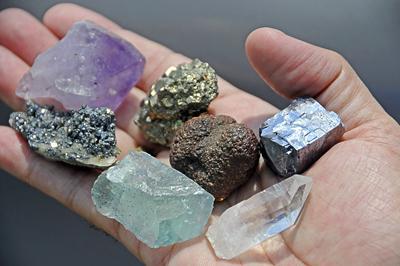
- native elements. This includes native metalloids and metals such as iron, platinum or gold, as well as non-metals such as diamond, sulfur and graphite.
- Sulfites, as well as their various analogues. The chemical classification of minerals includes salts such as pyrite, galena and others in this group.
- Oxides, hydroxides and their other analogues, which are a combination of a metal with oxygen. Magnetite, chromite, hematite, goethite are the main representatives of this category, which are distinguished by the chemical classification of minerals.
- Salts of oxygen acids.
- Halides.
It is also worth noting that in the group "salts of oxygen acids" there is also a classification of minerals by class:
- carbonates;
- sulfates;
- tungstates and molybdates;
- phosphates;
- silicates.
There are also three groups:
- igneous;
- sedimentary;
- metamorphic.
Origin
The classification of minerals by origin includes three main groups:
- Endogenous. Such processes of mineral formation in the majority of cases involve the intrusion into the earth's crust and subsequent solidification of underground hot alloys, which are commonly called magmas. At the same time, the formation of minerals itself is carried out in three steps: magmatic, pegmatite and postmagmatic.
- Exogenous. In this case, the formation of minerals is carried out under completely different conditions compared to the endogenous one. Exogenous mineral formation involves the chemical and physical decomposition of substances and the simultaneous formation of neoplasms that are resistant to another environment. Crystals are formed as a result of weathering of endogenous minerals.
- Metamorphic. Regardless of the ways in which rocks were formed, their strength or stability, they will always change under the influence of certain conditions. Rocks that are formed due to changes in the properties or composition of the original samples are commonly called metamorphic.
According to Fersman and Bauer
The classification of minerals according to Fersman and Bauer includes several rocks intended mainly for the manufacture of various products. It includes:
- gems;
- colored stones;
- organic stones.
Physical properties
The classification of minerals and rocks by origin and composition includes many names, and each element has unique physical properties. Depending on these parameters, the value of a particular breed is determined, as well as the possibility of its use in various fields of human activity.
Hardness
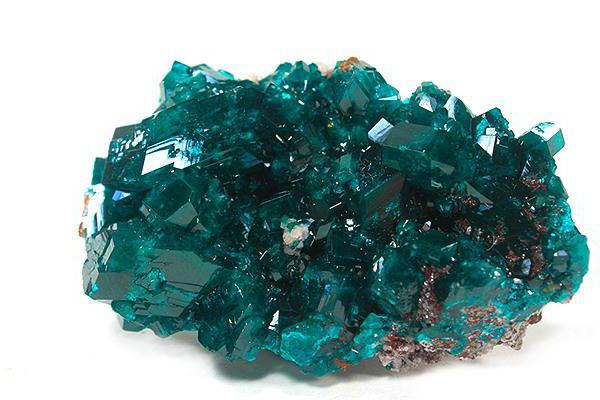
This characteristic represents the resistance of a certain solid body to the scratching effect of another. Thus, if the mineral in question is softer than the one with which its surface is scratched, traces will remain on it.
The principles of classification of minerals by hardness are based on the use of the Mohs scale, which is represented by specially selected rocks, each of which is capable of scratching previous names with its sharp end. It includes a list of ten items, which begins with talc and gypsum, and ends, as many people know, with diamond - the hardest substance.
Initially, it was customary to carry out the breed on glass. If a scratch remains on it, then in this case the classification of minerals by hardness already provides for assigning more than the 5th class to it. After that, the hardness is already specified according to Accordingly, if a scratch remains on the glass, then in this case a sample is taken from the 6th class (feldspar), after which they try to draw it on the desired mineral. Thus, if, for example, he left a scratch on the sample, but did not leave apatite, which is at number 5, he is assigned class 5.5.
Do not forget that, depending on the value of the crystallographic direction, some minerals may vary in hardness. For example, in disthene on the cleavage plane, the hardness along the long axis of the crystal has a value of 4, while across the same plane it increases to 6. Very hard minerals can only be found in the group with non-metallic luster.
Shine
The formation of shine in minerals is carried out due to the reflection of light rays from their surface. In any manual on minerals, the classification provides for the division into two large groups:
- with a metallic sheen;
- with non-metallic luster.
The former include those rocks that give a black line and are opaque even in fairly thin fragments. These include magnetite, graphite and coal. Minerals with a non-metallic luster and a color streak are also considered here as an exception. This applies to gold with a greenish streak, copper with a peculiar red streak, silver with a silvery white streak, and a number of others.
Metallic in nature is similar to the luster of a fresh fracture of various metals, and can be seen quite well on the fresh surface of the sample, even if considered. The classification of products with such a luster also includes opaque samples, which are heavier than the first category.
Metallic luster is characteristic of minerals, which are ore of various metals.
Colour
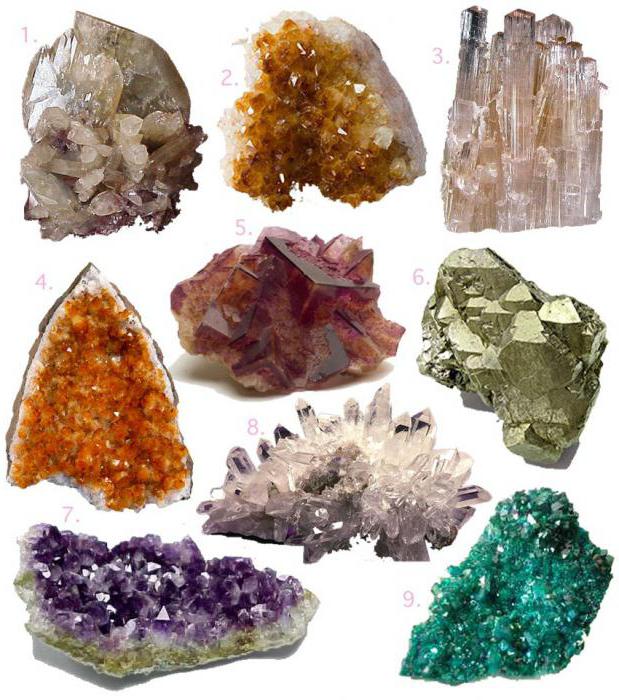
It should be noted that color is a constant feature only for some minerals. Thus, malachite always remains green, gold does not lose its golden yellow color, etc., while for many others it is unstable. To determine the color, you must first obtain a fresh chip.
Special attention should be paid to the fact that the classification of the properties of minerals also includes such a concept as the color of the line (ground powder), which often does not differ from the standard one. But at the same time, there are also breeds in which the color of the powder is significantly different from their own. For example, they include calcite, which can be yellow, white, blue, blue, and many other variations, but the powder will remain white anyway.
The powder, or trait of the mineral, is obtained on porcelain, which should not be covered with any glaze and is simply called "biscuit" among professionals. A line with the determined mineral is drawn along its surface, after which it is slightly smeared with a finger. We should not forget that hard, as well as very hard minerals do not leave behind any trace due to the fact that they will simply scratch this “biscuit”, so you first need to scrape off a certain part from them onto white paper, and then rub it to the desired state.
Cleavage
This concept implies the property of a mineral to split or split in a certain direction, while leaving a shiny smooth surface. It is worth noting the fact that Erasmus Bartholin, who discovered this property, sent the results of the research to a fairly authoritative commission, including such famous scientists as Boyle, Hooke, Newton and many others, but they recognized the discovered phenomena as random, and the laws invalid , although literally a century later it turned out that all the results were correct.
Thus, five main gradations of cleavage are provided:
- very perfect - the mineral can be easily split into small plates;
- perfect - with any blows with a hammer, the sample will split into fragments, which are limited by cleavage planes;
- clear or medium - when trying to split the mineral, fragments are formed, which are limited not only by cleavage planes, but also by uneven surfaces in random directions;
- imperfect - is found with certain difficulties;
- very imperfect - cleavage is practically absent.
Certain minerals have several directions of cleavage at once, which often becomes their main diagnostic feature.
kink
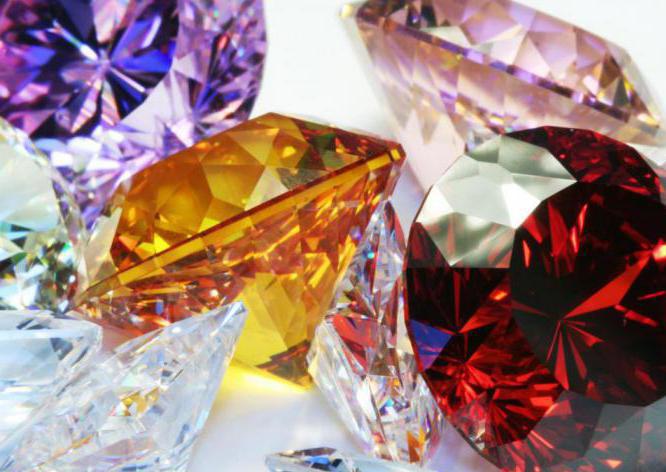
This concept means the surface of the split, which did not pass along the cleavage in the mineral. To date, it is customary to distinguish between the main five types of fractures:
- even - there are no noticeable bends on the surface, but at the same time it is not mirror-smooth, as is the case with cleavage;
- stepped - characteristic of crystals that have a more or less clear and perfect cleavage;
- uneven - manifested, for example, in apatite, as well as a number of other minerals that have imperfect cleavage;
- splintery - characteristic of fibrous minerals and is somewhat similar to a fracture of wood across the fibrous structure;
- conchoidal - in the shape of its surface it is similar to a shell;
Other properties
A fairly large number of minerals have such a diagnostic or distinguishing feature as magnetism. To determine it, it is customary to use a standard compass or a special magnetized knife. Testing in this case is carried out as follows: a small piece or a small amount of powder of the test material is taken, after which it is touched with a magnetized knife or horseshoe. If, after this procedure, the particles of the mineral begin to attract, this indicates that it has a certain magnetism. When using a compass, it is placed on some flat surface, after which they wait for the arrow to align and bring the mineral to it, without touching the device itself. If the arrow starts to move, this indicates that it is magnetic.
Certain minerals that contain carbonic salts, when exposed to hydrochloric acid, begin to release carbon dioxide, which manifests itself in the form of bubbles, which is why many people call this “boiling”. Among these minerals stand out: malachite, calcite, chalk, marble and limestone.
Also, some substances can be well dissolved in water. This ability of minerals is easy to determine by taste, and in particular, this also applies to others.
If it is required to conduct studies of minerals for fusibility and combustion, then you must first chip off a small piece from the sample, after which, using tweezers, bring it directly into the flame from a gas burner, spirit lamp or candle.
Forms of their presence in nature
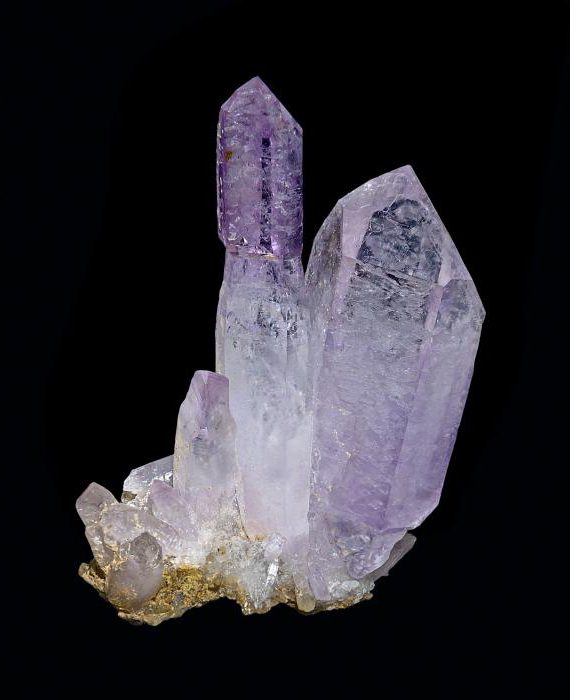
In the predominant majority of cases in nature, various minerals occur in the form of intergrowths or single crystals, and can also be shown in the form of clusters. The latter consist of a large number of grains having an internal crystalline structure. Thus, there are three main groups that have a characteristic appearance:
- isometric, equally developed in all three directions;
- elongated, having more elongated shapes in one of the directions;
- elongated in two directions while maintaining the third in a short form.
It should be noted that some minerals can form naturally intergrown crystals, which are then called twins, tees and other names. Such samples are often the result of intergrowth or intergrowth of crystals.
Kinds
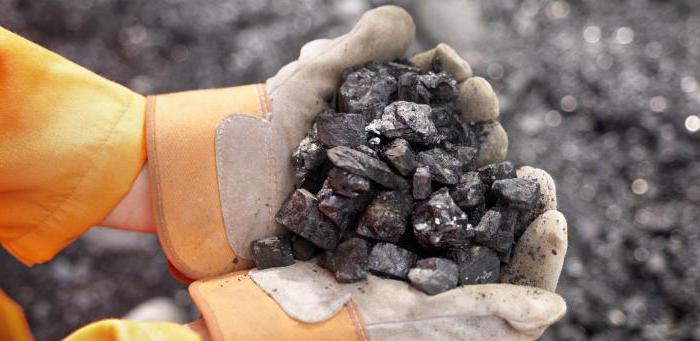
Do not confuse regular intergrowths and irregular aggregates of crystals, for example, with “brushes” or druses that grow on the walls of caves and various cavities in rocks. Druses are intergrowths formed from several more or less regular crystals and at the same time growing at one end to some kind of rock. Their formation requires an open cavity, which provides for the possibility of free growth of minerals.
Among other things, many crystalline minerals are distinguished by rather complex irregular shapes, which leads to the formation of dendrites, sinter forms, and others. The formation of dendrites is carried out due to the too rapid crystallization of minerals located in thin cracks and pores, and the rocks in this case begin to resemble rather bizarre plant branches.
Often there are situations when minerals almost completely fill a small empty space, which leads to the formation of secretions. They use a concentric structure, and the mineral substance fills it to the center from the periphery. Sufficiently large secretions, in which an empty space remains inside, it is customary to call geodes, while small formations are called tonsils.
Concretions are concretions of an irregular round or spherical shape, the formation of which occurs due to the active deposition of mineral substances around a certain center. Quite often, they are characterized by a radially radiant internal structure, and unlike secretions, growth occurs, on the contrary, towards the periphery from the center.
